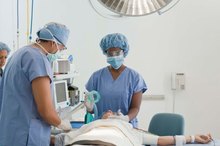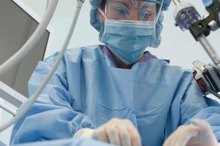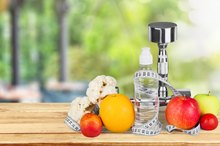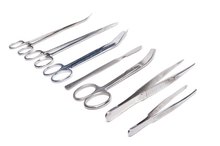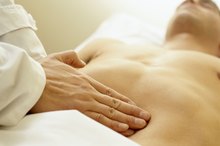What Are the Weight Lifting Limits After Gallbladder Removal?
The gallbladder aids in digestion, delivering bile from the liver to the small intestine. Although the gallbladder is a functional organ, it is not necessary to to sustain life. For this reason, it can be surgically removed if your doctor feels this is necessary. Regardless of the procedure used for removal, there will be aftercare restriction such as weight lifting limits. It is important to follow your doctor’s instructions.
Removal Indications
Any gallbladder disease can require the removal of your gallbladder but the most common problem is gallstones 4. Gallstones are hard, rock-like particles in your gallbladder that can lodge is your cystic or bile ducts. Eighty percent of gallstones are made from cholesterol, according to the National Institute of Diabetes and Digestive and Kidney Diseases 3. If the stones stop the flow of bile, serious complications can occur. Cholecystectomy or removal of your gallbladder would then be necessary. The weight restrictions and aftercare placed on you after removal depend on how your gallbladder is removed.
- Any gallbladder disease can require the removal of your gallbladder but the most common problem is gallstones 4.
Laparoscopic Gallbladder Removal
Side Effects of Gallbladder Surgery
Learn More
A laparoscopic removal is the first choice of most physicians. This requires the surgeon to make tiny incisions in your abdomen so he can insert a small camera to guide him as he performs the procedure. The smaller incisions will both reduce pain and the risk of complications. The Colorado Springs Surgical Associates recommends not lifting any weight over 20 pounds from four to six weeks after a laparoscopic procedure 1. Lifting too much weight can cause a hernia at the umbilical incision.
- A laparoscopic removal is the first choice of most physicians.
- Lifting too much weight can cause a hernia at the umbilical incision.
Open Gallbladder Removal
Open gallbladder removal is more invasive, requiring a bigger incision 2. The surgeon will then reach into the cavity and remove the gallbladder. The recovery process is therefore longer than the laparoscopic approach. Due to the size of the incision, you should not lift anything over 10 to 15 pounds until your doctor grants permission in about four to eight weeks.
- Open gallbladder removal is more invasive, requiring a bigger incision 2.
- The surgeon will then reach into the cavity and remove the gallbladder.
Considerations
How to Treat Gas Pain After Laparoscopic Gallbladder Surgery
Learn More
Each surgeon has his post-surgical protocol. It is important to precisely follow his instructions to ensure a smooth healing process. If you question whether something is too heavy to lift, talk with your doctor and first get his opinion. When in doubt, do not lift anything heavier than a glass of water without approval.
- Each surgeon has his post-surgical protocol.
- If you question whether something is too heavy to lift, talk with your doctor and first get his opinion.
Related Articles
References
- Colorado Springs Surgical Associates: Laparoscopic Gallbladder Removal
- Medline Plus: Gallbladder Removal - Open - Discharge
- National Institute of Diabetes and Digestive and Kidney Diseases: Gallstones
- University of Maryland Medical Center: Gallstones and Gallbladder Disease - Symptoms
- UpToDate. Updated January 24, 2018.
- Eating, Diet, & Nutrition for Gallstones. National Institute of Diabetes and Digestive and Kidney Diseases. Published November 1, 2017.
- Treatment for Gallstones. National Institute of Diabetes and Digestive and Kidney Diseases. Published November 1, 2017.
- Gallstones: MedlinePlus Medical Encyclopedia. MedlinePlus. Updated September 11, 2019.
- Ahmed M, Diggory R. Acalculous gallbladder disease: the outcomes of treatment by laparoscopic cholecystectomy. Ann R Coll Surg Engl. 2011;93(3):209-12. doi:10.1308/003588411X563402
- Han HS, Yoon YS, Agarwal AK, et al. Laparoscopic Surgery for Gallbladder Cancer: An Expert Consensus Statement. Dig Surg. 2019;36(1):1-6. doi:10.1159/000486207
- Surgery for Gallbladder Cancer. American Cancer Society. Updated July 12, 2018.
- UpToDate. Updated February 21, 2018.
- Updated January 24, 2018.
- Karimi G, Vahabzadeh M, Lari P, Rashedinia M, Moshiri M. "Silymarin", a promising pharmacological agent for treatment of diseases. Iran J Basic Med Sci. 2011;14(4):308-17.
- Eating, Diet, & Nutrition for Gallstones. National Institute of Diabetes and Digestive and Kidney Diseases. Published November 1, 2017.
- Dieting & Gallstones. National Institute of Diabetes and Digestive and Kidney Diseases. Published November 1, 2017.
- American Cancer Society. (n.d.). Treating Gallbladder Cancer.
- Jessri M, Rashidkhan B. Dietary patterns and risk of gallbladder disease: A hospital-based case-control study in adult women. J Health Popul Nutr. 2015 Mar;33(1):39-49.
- Lee JY, Keane MG, Pereira S. Diagnosis and treatment of gallstone disease. Practitioner. 2015 Jun;259(1783):15-9,2.
- Moga MM. Alternative treatment of gallbladder disease. Med Hypotheses. 2003 Jan;60(1):143-7.
- Stinton ML, Shaffer EA. Epidemiology of Gallbladder Disease: Cholelithiasis and Cancer.Gut Liver. 2010 Apr;6(2):172-87.
- Tringali A, Loperfido S. (2018). Patient education: ERCP (endoscopic retrograde cholangiopancreatography) (Beyond the Basics). Howell DA (ed). UpToDate, Waltham, MA: UpToDate Inc.
- Wen FY, Li SC, Wang GM, Li LX, Song YQ. [Effects of acupuncture of Jianjing (GB 21) on gallbladder volume and symptoms of cholecystitis patients]. Zhen Ci Yan Jiu. 2012 Oct;37(5):398-402.
Writer Bio
Matt Berry is a radiologic technologist who started writing professionally in 2007. He specializes in health and medical articles and has been published in "Radiologic Technology." Berry holds a Bachelor of Science in radiology technology from Mount Marty College and is credentialed in radiography and computed tomography with the American Registry of Radiologic Technologists.
